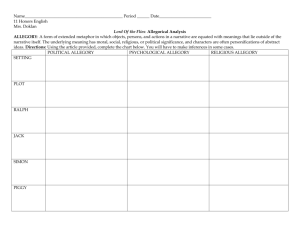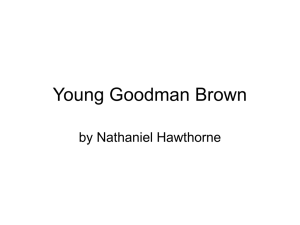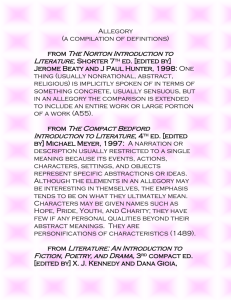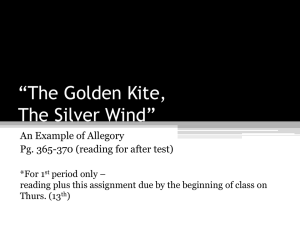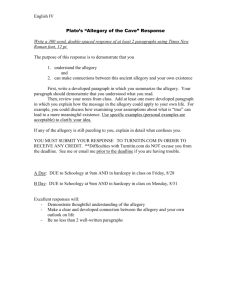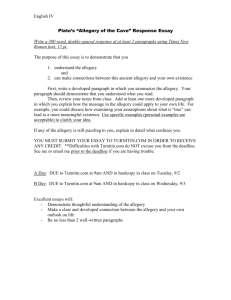the allegory as exegesis paradigm in rabbinic literature and in greek
advertisement
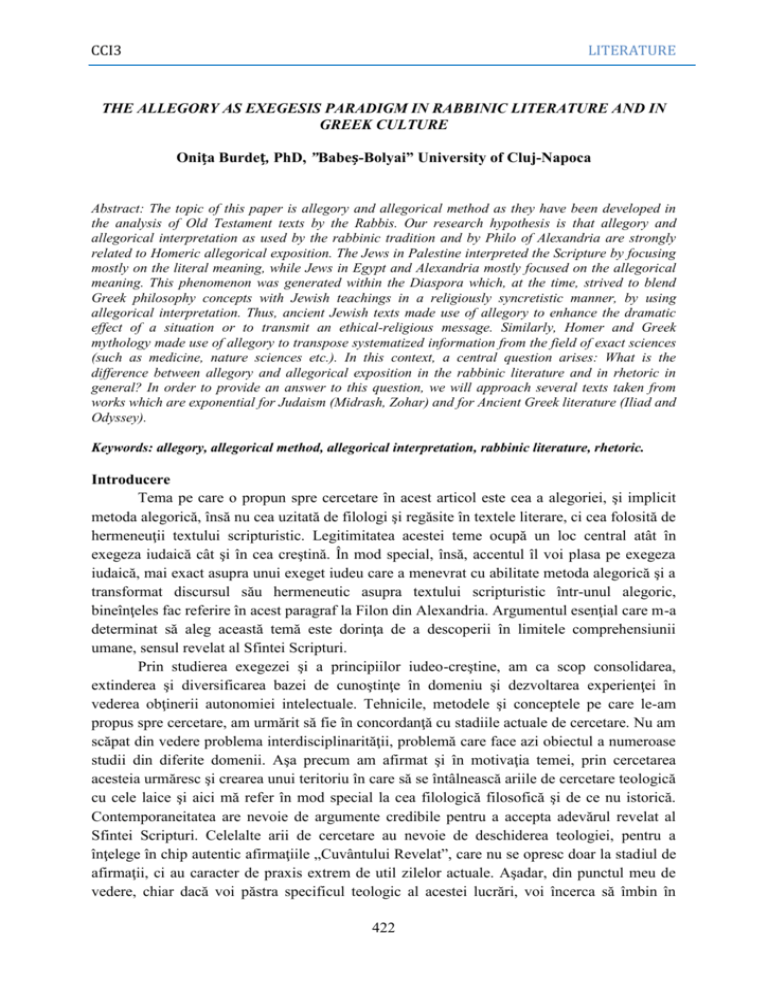
CCI3 LITERATURE THE ALLEGORY AS EXEGESIS PARADIGM IN RABBINIC LITERATURE AND IN GREEK CULTURE Onița Burdeț, PhD, ”Babeș-Bolyai” University of Cluj-Napoca Abstract: The topic of this paper is allegory and allegorical method as they have been developed in the analysis of Old Testament texts by the Rabbis. Our research hypothesis is that allegory and allegorical interpretation as used by the rabbinic tradition and by Philo of Alexandria are strongly related to Homeric allegorical exposition. The Jews in Palestine interpreted the Scripture by focusing mostly on the literal meaning, while Jews in Egypt and Alexandria mostly focused on the allegorical meaning. This phenomenon was generated within the Diaspora which, at the time, strived to blend Greek philosophy concepts with Jewish teachings in a religiously syncretistic manner, by using allegorical interpretation. Thus, ancient Jewish texts made use of allegory to enhance the dramatic effect of a situation or to transmit an ethical-religious message. Similarly, Homer and Greek mythology made use of allegory to transpose systematized information from the field of exact sciences (such as medicine, nature sciences etc.). In this context, a central question arises: What is the difference between allegory and allegorical exposition in the rabbinic literature and in rhetoric in general? In order to provide an answer to this question, we will approach several texts taken from works which are exponential for Judaism (Midrash, Zohar) and for Ancient Greek literature (Iliad and Odyssey). Keywords: allegory, allegorical method, allegorical interpretation, rabbinic literature, rhetoric. Introducere Tema pe care o propun spre cercetare în acest articol este cea a alegoriei, şi implicit metoda alegorică, însă nu cea uzitată de filologi şi regăsite în textele literare, ci cea folosită de hermeneuţii textului scripturistic. Legitimitatea acestei teme ocupă un loc central atât în exegeza iudaică cât şi în cea creştină. În mod special, însă, accentul îl voi plasa pe exegeza iudaică, mai exact asupra unui exeget iudeu care a menevrat cu abilitate metoda alegorică şi a transformat discursul său hermeneutic asupra textului scripturistic într-unul alegoric, bineînţeles fac referire în acest paragraf la Filon din Alexandria. Argumentul esenţial care m-a determinat să aleg această temă este dorinţa de a descoperii în limitele comprehensiunii umane, sensul revelat al Sfintei Scripturi. Prin studierea exegezei şi a principiilor iudeo-creştine, am ca scop consolidarea, extinderea şi diversificarea bazei de cunoştinţe în domeniu şi dezvoltarea experienţei în vederea obţinerii autonomiei intelectuale. Tehnicile, metodele şi conceptele pe care le-am propus spre cercetare, am urmărit să fie în concordanţă cu stadiile actuale de cercetare. Nu am scăpat din vedere problema interdisciplinarităţii, problemă care face azi obiectul a numeroase studii din diferite domenii. Aşa precum am afirmat şi în motivaţia temei, prin cercetarea acesteia urmăresc şi crearea unui teritoriu în care să se întâlnească ariile de cercetare teologică cu cele laice şi aici mă refer în mod special la cea filologică filosofică şi de ce nu istorică. Contemporaneitatea are nevoie de argumente credibile pentru a accepta adevărul revelat al Sfintei Scripturi. Celelalte arii de cercetare au nevoie de deschiderea teologiei, pentru a înţelege în chip autentic afirmaţiile „Cuvântului Revelat”, care nu se opresc doar la stadiul de afirmaţii, ci au caracter de praxis extrem de util zilelor actuale. Aşadar, din punctul meu de vedere, chiar dacă voi păstra specificul teologic al acestei lucrări, voi încerca să îmbin în 422 CCI3 LITERATURE acelaşi timp şi principiile lingvisticii, semioticii şi semanticii, împreunate toate într-un discurs istoric. Hermeneutica, acest domeniu în contemporaneitate este unul complex, care-şi găseşte proiectarea şi în alte domenii din afara teologicului. Pe lângă toate acestea, disciplina aceasta a exegezei, în ceea ce priveşte dezvoltarea personală a unei viitoare activităţii de cercetare independente, mai are un rol de „disciplinare intelectulă”. 1. Allegory as an exegesis paradigm The paper I want to present to you today has the title: The Allegory as an Exegesis Paradigm in Rabbinic Literature and in Greek Culture. The premise from which I started to write this article was that allegory and allegorical interpretation, as phenomena identified both within the Rabbinic writings and in the works of Philo of Alexandria, are closely linked to several poems of the Greek literature. In order to achieve a complete analysis of this theme, I must stop, firstly, on the origins of the biblical exegesis. The beginning of this science is placed within the Jewish exegesis, which was born after the Babylonian exile, when the Jewish no longer spoke the biblical Hebrew and, in order to know God’s words, were forced to call on the scribes, who at the very beginning were only translators of the holy books, and then started to accompany their translations with short interpretations. From this point on it was only a matter of time until the accent was transferred from the biblical Logos on that of the scribes, and the interpretation is transformed into scholarship whilst the devoutness becomes liturgical and legalist formality. The fact is the the Jewish divided the explanations into two categories: “Halakha” (teachings that referred to the Mosaic Law and which were compulsory, acting as canon for life) and “Haggadah” (discourses about the biblical teachings and about other parts of the Bible). Of these two expository components, the two parts of the Talmud1 develop: Mishnah and Gemara. Besides these two, the Jewish also have other commentaries to the Holy Scripture (Midrashim2) and translations from Hebrew into Aramaic (Targumim), which sometimes are not only translations but also paraphrases and even interpretations. The word midrash marks a Rabbinic commentary inspired by the text of Torah, with the purpose to explain the judicial problems or to transmit a certain moral feature, using different literary genres (e. g. narration, parable, legend). The midrash is translated from Hebrew with the verbs “to search, to study”. It seems that in the beginning, the first wise men studied the texts of Torah in “bet midrash” (translation: house for study). “The written Law being most often elliptic, they struggled to go beyond the literal meaning of the text in order to find the essence, the implicit meaning. Although frequenting the houses of study was considered to be 1 According to the schools of interpretation which developed them, we have two Talmuds: a Babylonian one and a Palestinian one, both from the 3rd-4th century AD. The Babylonian Talmud is bigger than the Palestinian one. 2 The beginnings of the Jewish Biblical exegesis may be placed, from a chronological point of view, in a period in which most of the books that are now part of the Old Testament Canon, were yet unknown. The Hebrew verb “darash” is the root of the noun “midrash” and it refers to the chapter 7, verse 10 of the Book of Ezra. The English translation of the mentioned verb is “to seek”, which means to investigate, to search, and in connection to what I previously stated, it denotes the action to search the biblical text, to find its hidden meaning. This reference to the biblical text from Ezra is the oldest mention of the biblical exegesis. In fact, Ezra is the one who reorganized the religious life of the Jewish people and imposed on them the primacy of Torah, thus, Ezra “may be considered founder of the biblical exegesis”. Two institutions have their origins during this period: the synagogue and the academy. In agreement with the origins and the nature of these two institutions, the exegesis became a means of education and of guarding the oral tradition. 423 CCI3 LITERATURE an important action, the rabbis used to say that “practice is more important than the study [midrash]” Avot1:17. During the era of Tannaim, Midrash is divided into two distinctive structures: Midrash Halakha and Midrash Haggadah. Midrash Halakha is composed of texts written based on the teachings taught in academies, having as purpose the extraction of laws from the registered texts and their thorough interpretation. Midrash Haggadah has its origins in the synagogal sermons, respectively in homiletic stories and moralistic stories. On this basis of exegetical interpretation a school of thinking is developed of which the main current amongst the wise men of the Talmud is claimed, founded by a so-called Hillel3. 2. Philo of Alexandria – the best allegorical exegete The information on Philo’s life are scarce, but with their help one may recompose a brief biography, susceptible to offer to some extent the purpose and the content of his rich work, of which only a few books have been translated into Romanian. Two windows towards the troubled times that influenced not only Philo’s life but also the existence of the Jewish Diaspora. Another source of information is the historian Josephus Flavius. Philo was born and raised, excepting the period of his short residence in Rome, in Alexandria. Both the date of his birth and of his death were the object of many controversies, but it would be reasonable for us to believe that he was born around 20 BC and died around 50 AD4. When one writes about Philo, usually it is emphasized the controversy that the researchers have regarding the boundary line between the areas of influence, Jewish and Platonic, in his thinking. It has been said that, by virtue of his Hellenistic education, Philo was at first a fervent Platonist and, subsequently, in his quest to explore his religious roots, he passionately researched the Jewish inheritance he had received and tried a reconciliation of the ancient traditions of his people with his disposition towards the Greek scholarship of the time5. One must not forget that, apart from these two traditional sides around which his thinking is typically circumscribed, Philo is deeply eclectic: from Plato he took the faith in the transcendental God and in the eternity of the soul, from the Stoics he took a powerful sense of the universal order and the exaltation of apatheia, from Neopythagoreans he took the sympathy for the monastic groups such as those from the border of lake Mareotis. This leads us to conclude that his spiritual ideal is in fact a mixture of Stoicism and Platonism6. As William Fairweather remarked, Philo’s system lacks harmony, because Greek speculative ideas are mixed with positive truths of the revealed religion7. 3 What we know about the life of this learned man is feeble, for there is no historical testimony. The one who covers from a historical point of view the period in which this wise man lived is Josephus Flavius (70 BC10AD), but he does not make any reference to Hillel. What we have left from this exegete is his teaching gathered from the oral tradition of Judaism, which would constitute the Talmud and Midrash for many centuries after his life and death. 4 David M. Scholer, “An introduction to Philo Judaeous of Alexandria”, in C. D. Yonge (trans.), The Works of Philo. Complete and Unabridged (Hendrikson: Peabody, 1993), xi. 5 David Winston, “Philo and the Contemplative Life”, in Arthur Green, Jewish Spirituality (New York: Crossroad, 1986), 199. 6 Anthony Meredith, “Philo”, in Cheslyn Jones, Geoffrey Wainwright and Edward Yarnold (eds.), The Study of Spirituality, New York (Oxford: University Press, 1986), 95. 7 William Fairweather, Jesus and the Greeks or Early Christianity in the Tideway of Hellenism (Edinburgh: T&T Clark, 1924), 187. 424 CCI3 LITERATURE The Jewish community of Alexandria, in which Philo was educated, was divided into two sides. One of them belonged to the fundamentalists, who opposed the allegorical explanation of the Scripture, and the other one belonged to the liberals, who challenged any other interpretation excepting the allegorical one8. The philosopher of Alexandria is the continuator of an important tradition which goes back into history to the translators of the Septuagint or to thinkers such as Aristeas and Aristobulus, considered to be amongst the first Jewish allegorizers of the Bible9. The allegorical interpretation of the old texts was not an innovation of the Jews from Alexandria. The Greek culture also had a pattern of thinking according to which one should have looked into the writings of Homer or Hesiod for a profound speculative sense10. As a scholar educated in the spirit of the Hellenistic tradition, Philo puts an emphasis on reason and feeds, in parallel, great suspicions towards the narrations with a mythical aspect or generated by an incontrollable imagination. For example, interpreting the divine voice that spoke to Moses from the burning bush, Philo manifests suspicions against the possibility that the narration had anything miraculously or magical in it11. Allegory meant, in parallel, practicing an exegesis that was widely spread during his time and which was accepted as part of the normal sphere even by the most sophisticated readers12. According to Philo’s conception, an allegorical interpret must start from the premise that the sacred text is a comprising cryptogram that hides under its narrative mask, clues and information on the moral and natural order of the world. For example, the biblical narration about Hagar’s expulsion by Abraham illustrates the manner in which the good man casts out the temptation of his passions as a consequence of his submission to the intellect13. Apart from his Platonism, Philo guards a profound attachment to the Jewish thinking, from which he does claim himself in a sophisticated manner. According to him, the Plato’s great ideas are barely sparks of the divine revelation given to Moses. Through his allegorical programme, the Hellenistic philosopher discovers within the Law and Prophets the entire Platonist philosophy, but ends up “creating a hybrid that has neither the force of the Platonism nor that of the Judaism”14. 3. Greek culture – Homer and the Iliad and the Odyssey In this part I was forced, at first, to deal with the meanings of the term “allegory” in order to identify the semiological distinction that produces within the field of rhetoric. Allegory, from a philological point of view, is considered to be different from an apologue, but identical to the parable. The allegory and the parable are considered to be figures of speech15 and the apologue is part of the literary genres and species. In order to 8 Don Martindale, Social Life and Cultural Change (Princeton: N. J., Van Nostrand, 1962), 506 A. Meredith, “Philo”, 94. 10 G. W. F. Hegel, Lectures on the History of Philosophy (Lincoln: University of Nebraska Press, 1995), 388. 11 Denise Lardner Carmody & John Tully Carmody, Mysticism: Holiness East and West (New York: Oxford University Press, 1996), 151. 12 D. Winston, Philo, 199. 13 Louis Jacobs, The Jewish Religion: A Companion (Oxford University Press, 1995), 377. 14 Benjamin W. Bacon, “Formative Influences” in Thomas S. Kepler (ed.), Contemporary Thinking about Paul: An Anthology (New York: Abingdon Cokesbury Press, 1950), 112. 15 The figure of speech is a device used with the purpose of increasing the expressiveness of communication. The figures of speech may act on formal level of a phrase (through repetition, inversion, anacoluthon etc), or they 9 425 CCI3 LITERATURE present exchaustingly this theme, it is of high importance to start my research from the literary definition of this word, and then t observe the characteristics of this figure of speech in the theological field. In a philological sense, allegory represents the invocation of an image with the help of another image, by virtue of the fact that the latter has a certain bond with the one that it represents. In a narrow sense, allegory is the figure of speech consisting of a series of metaphors, comparisons, personifications, composing a uniform image, in which the poet suggests abstract notions with the help of the concrete16. Allegory can also be found in the field of rhetoric. But from the rhetoric’s perspective, allegory is defined in a completely different way. Thus, allegory is a figure of speech “presenting a full communication of a meaning hidden beyond the initial sense, through an ensemble of equivalences completely decipherable rationally”17. In general allegory is associated to personification and comparison, and depending on the movement element it is associated to parable and apologue, but most often it is considered to be “a prolonged metaphor”, a “variety of the metaphor”18. From a rhetoric point of view, allegory has two distinctive meanings. Thus, to allegorize in speech or in writing proves a rhetoric strategy that uses short commentaries framed into a metaphorical language. The second meaning is identified with the action of interpreting an allegorical text involuntary by the author, we refer here to a hermeneutical device. Caird identifies five allegorical categories: rationalist allegory (rescinded in a sacred text), moralist allegory (the search of moral truth in high level narrative forms), atomic allegory (a phrase invented by Moore for the allegorical method used by the rabbis who interpret sentences, phrases and even words independently from the context or from the historical situation in which they are placed), and the final category is of the polemic allegory (used because of the fact that it was preferred by the opponents; e. g. in the case of the disciple Paul who fought against the Greek sophism). A classification used prior to this by the biblical interprets from outside the rabbis wisdom (according to Wolfson, 1957, 25-30) had may act on the notional level (with the help of the metaphor, synecdoche, hyperbole). Sometimes, the figures of speech act upon the meanings and are considered to be tropes and not figures of speech. According to other opinions, the figure of speech and the trope are synonyms. Irina Petraş, Teoria literaturii. Curente literare. Figuri de stil. Genuri şi specii literare. Metrică şi prozodie. Structura operei literare (Theory of Literature. Literary Movements. Figures of Speech. Literary Genres and Species. Metrics and Prosody. The Structure of the Literary Work) (Cluj-Napoca: Apostrof Library, 2009), 77. Allegory – artistic device consisting of expressing an abstract idea with the help of concrete means. 2. Literary or artistic work using this type of expression (apologue, parable) – from Fr. Allégorie, Lat. allegoria – DEX (Explanatory Dictionary of the Romanian Language) 16 Literary allegory is “an invention or an mage determined by substitution”. The most eloquent example from the autochthonous popular literature is often recognized to be the ballad “Mioriţa” where death is presented as a wedding, it is in fact an ample allegory that presents the passing from an abstract level of a notion (death), to another (wedding) with the help of a long series of metaphors and personifications. For a more complex definition from a philological point of view see: Mariana Robănescu, Dicţionar de termini literari şi figuri de stil (Dictionary of Literary Terms and Figures of Speech) (Bucharest: Amethyst 92, 2005), 17. Allegory is a representation under a human (the most common case), animal or vegetable form of a proverbial deed, of a situation, virtue or abstract being. A feathered woman is the allegory of victory, the cornucopia is the allegory of abundance. Henry Corbin defines its status, establishing the differences between allegory and other figures of speech: “Allegory is the result of a rational operation that does not imply the passing neither to another existential level nor to an unknown abyss of the conscience: allegory is the figurative expression at the same level of consciousness of what cannot be discovered in any other way”. Jean Chevalier, Dicţionar de simboluri (Dictionary of Symbols) (Bucharest: Artemis, 1995), 40. 17 Val Panaitescu et all., Terminologie poetică şi retorică (Poetic and Rhetoric Terminology) (Iassy: University Al. I. Cuza Press, 1994), 5. 18 Quintilian, Institutio oratoria. 426 CCI3 LITERATURE the following content: allegory, legal, prudential, creedal, rational, historical, predictive and eschatological predictive. But this distinction used by Craid and Wolfson is not fully accepted because it is based on a “conglomerate” of reasons and have a poor content from a qualitative point of view regarding the methods of interpretation. The allegorical interpretation is an attempt to de-particularize a text (of its initial meaning) with the purpose to induce a “universal applicability”. Some exegetes of the Antiquity start from the premise that the authors are fully aware of the allegorical sense of their narration. D. A. Russell, in one of his works, states the following: “No one in Antiquity seems to have had the idea that, instead of beginning with a message and embodying it in fiction one might begin with a story or subject and treat it as a symbol of happening or truths which have some formal resemblance to it”19. Reading the Homeric texts in an allegorical key has its origins in the 6th century BC. Theagenes of Regium (525 BC), the so-called inventor of the allegorical interpretation (Tatian, Adv. Graecos, 31), stated that the war between the Olympian gods represents in fact elements of the nature (warm, wet, dry, cold) or aspects of the human psychology (Dowden 1992, 40-41). Some wise men of the Hellen Antiquity, amongst which we may mention Xenofanes, deplore the fact that Homer and Hesiod attribute to the gods what is shameful for humans (Clement, Stromata 5.110). What is harmful can be eliminated through excision (Plato, The Republic 2.387b), or hidden with the help of the allegorical interpretation. Socrates presented by Plato, makes an irony through which he suggests that the golden chain with which Zeus transformed other Olympian gods into war machines is nothing else but the “sun” (Plato, Theaet. 153c). In the Greek world, the allegorical interpretation practiced by Homer and the Stoics constitutes both an analogy and a precedent for use in the primary Christianity. The hypothesis from which the Greek Sophia starts in defining the allegory is that “” (reason) has its origins in “” (story, myth). The contemporary researchers have not yet reached an agreement regarding what truly defines the allegorical interpretation (a positive philosophical technique or a defensive tactic in order to defend the poets against the “philosophical attacks” – Dawson 2000, 90). Some of the works dedicated to the Homeric allegory dated in the first centuries AD have survived contemporaneity, of which I mention: Cornutus, De natura deorum, Heraclitus, Quaestiones homericae and Pseudo-Plutarch, De vita et poesi Homeri. These authors manifested the belief that Homer and the Greek mythology transposed within the text systematized information on medicine, natural sciences and philosophy but they were hidden under the mask of allegory20. I must admit here that this opinion is innovative in the field of the allegorical usage. Hence, if I were to follow this idea, most of the Homeric treatises considered to have a humanistic character, hide information on the exact sciences practiced during those times. The Neoplatonists (3rd-5th century BC) were the ones in charge with the full interpretation of the Homeric works and of Plato’s Republic in an allegorical key. 19 D. A. Russell and N. G. Wilson, eds., Menander rhetor. A Commentary (Oxford: Clarendon Press, 1981), 97. I found this innovative idea according to which allegory is a defense weapon against those who might have tried to steal the secrets of the Greek scholars presented in the book of Aune, E. David, The Westminster Dictionary of New Testament and Early Christian Literature and Rhetoric. (Kentucky: Westminster John Knox Press, 2003), 31. 20 427 CCI3 LITERATURE Concluzii Prin aducerea în discuţie a câmpului retoricii, consider că perspectiva de abordare a alegoriei s-a întregit. Mai apoi trecând din câmpul figurii la cel al metodei, am scos în evidenţă modalitatea în care exegetul prin excelenţă alegoric, Filon, îşi construieşte discursul său exegetic. Concluzionând cele expuse pot afirma că în Vechiul Testament predomină alegoria iar în Noul Testament locul acesteia este preluat de parabolă. Această înlocuire a alegoriei cu parabola poate fi pusă pe seama faptului că iudaismul întotdeauna a considerat esenţial studiul Torei şi instruirea rabinilor în spiritul respectării legilor învăţate în şcoli şi sinagogi, astfel că, sensul alegoriei din textele scripturistice putea fi descifrat doar de cei care parcurgeau acest ciclu al iniţierii intelectuale. În schimb, în Noul Testament, studiul textelor sacre este înlocuit de hermeneutica Mântuitorului impregnată de un profund caracter pedagogic. În ce priveşte alegoria şi metoda alegorică acestea constituie încă paradigme cu valenţe multiple pentru exegeza textelor scripturistice. Ca procedeu stilistic, alegoria este foarte răspândită în textul sacru şi de cele mai multe ori ea se ridică la cele mai înalte exigenţe, adăugând prospeţime stilului şi mijlocind în mod admirabil concepte abstracte prin intermediul unor comparaţii concrete sau metafore. „Este adevărat însă că în Vechiul Testament, alegoria este uneori vulgară, indecentă (Iez. 16.) şi nepotrivită cu conţinutul ideilor morale.” Dar aceste „imperfecţiuni” cu siguranţă că au influenţat plasticitatea naraţiunilor şi forma acestora care ascundeau sub perdeaua alegorică un profund caracter realist. În acelaşi timp ar fi greşit în analiza şi interpretarea acestor texte să se accepte doar sensul alegoric, căci, atunci naraţiunile s-ar transforma în mitologii, diminuându-se considerabil importanţa acestora. Bibliografie I. Izvoare scripturistice Biblia sau Sfânta Scriptură, Editura Institutului Biblic şi de Misiune al BOR, Bucureşti, 2006(editie sinodală). Biblia sau Sfânta Scriptură, Ediţie jubiliară a Sfântului Sinod, versiune diortosită după Septuaginta, redactată şi adnotată de Bartolomeu Valeriu Anania Arhiepiscopul Clujului, Ed. IBMBOR, Bucureşti, 2001. Biblia adecă Dumnezeiasca Scriptură a Vechiului şi Noului Testament, tipărită întâia oară la 1688 în timpul lui Şerban Vodă Cantacuzino, Domnul Ţării Româneşti. Retipărită după 300 de ani în facsimil, cu aprobarea Patriarhului Bisericii Ortodoxe Române, Ed. IBMBOR, Bucureşti, 1977. Biblia sau Dumnezeiasca Scriptură a Legii Vechi şi a ceii Noao-1795, ediţie jubiliară, Tipografia Vaticana, Roma, 2001. The Orthodox Jewish Bible: Tanakh and Orthodox Jewish Brit Chadasha, Phillip E.Goble (ed), AFI International Publishers, New York, 2003. The Greek New Testament, 4th Revised Edition With English Introduction including Greek/English dictionary, Edited By: Barbara Aland, Kurt Aland, Johannes Karavidopoulos, Carlo Martini, Bruce Metzger, Deutsche Bibelgesellschaft. Codex Sinaiticus Petropolitanus, Preserved in the imperial Library of St.Petersburg. Reproduced in Facsimile by Helen and Kirsop Lake, Oxford Clarandon Press, 1911. 428 CCI3 LITERATURE CODEX LENINGRADENSIS St Petersburg, Firkovich Bibl. II.B.19a. Biblia completa con i segni delle vocali e degli accenti e con la masorah magna et parva. Carpet pages. From Damascus. Biblia Sacra, Iuxta Vulgatam Versionem, Recensit H.F.D. Sparks, W.Thiele, Recensit et brevi apparatu instruxit Robert Weber OSB, Tomus I, Württembergische Bibelanstalt Stuttgart, 1969. BNT+LXX, BNT - Novum Testamentum Graece, Nestle-Aland 27h Edition. Copyright (c) 1993, Deutsch Bibelgesellschaft, Stuttgart. LXT - LXX Septuaginta (LXT) (Old Greek Jewish Scriptures) edited by Alfred Rahlfs, Copyright © 1935 by the Württembergische Bibelanstalt /Deutsche Bibelgesellschaft (German Bible Society), Stuttgart. The Niv Study Bible- New International Version, Zondervan Bible Publishers Grand Rapids, Michigan, 1985. Biblia Hebraica Stuttgartensia, Editio Funditus Renovata, ediderunt P. Kahle, K.Elliger et W.Rudolph, Deutsche Bibelgesellschaft Stuttgart, 1976.. Biblia Hebraica, ediderunt R.Kittel, Deutsche Bibelgesellschaft Stuttgart, 1967. King James Version- 1769 Blayney Edition of the 1611 KJV of the English Bible- with Larry Pierce’s Englishman’s- Strong’s Numbering System, ASCII version.- format electronic The Holy Bible, American Standard Version, 1901 (ASV), similar to the English Revised Version of 1881-1885, both being based upon the Hebrew Masoretic text for the OT and upon the Westcott- Hort Greek text for the NT. – format electronic The English Bible in Basic English 1949-1964 (BBE), Published by Cambridge Press, England, 1965. Biblia sacra juxta Vulgatam Clementinam 1598, with Glossa Ordinaria Migne edition (1880). Glossa Ordinaria Migne, edition 1880, with some additions and emendations from the Editio Princeps published by Brepols in facsimile. Format electronic. Nova Vulgata Bibliorum Sacrorum Editio (NOV), Sacrosanti Oecumenici Concilii Vaticanii II, ratione habita Iussu Paulii VI recognita et promulgata. Format electronic. Translatio Syra Pescitto ETERIS TESTAMENTI, Ex Codice Ambrosiano Sec. Fere VI, Photolithographice Edita, curante et adnotante Antonio Maria Ceriani, Tomus I. Hebrew English Edition of The Babylonian Talmud, Baba Bathra, translated into english with notes, glossary and indices by A. E. Silverstone, Rabbi I. Epstein, London, The Soncino Press, 1994. Hebrew-English Edition of the Babylonian Talmud, Translated into English with notes, glossary and indices, by Rabbi Samuel Daiches (Folios 2A-36B) and Israel W.Slotki (36B-to the end), London: Soncino Press, 1989. II. Dicţionare, comentarii Attias, Jean-Christopher, Dicţionar de civilizaţie iudaică, Univers Enciclopedic, Bucureşti, 1975. Dicţionar Enciclopedic de iudaism, traducere de V. Prayer, C.Litman, Ţ.Goldstein, Hasefer, Bucureşti, 2001. Wigoder Geoffrey(coord.), Enciclopedia iudaismului, Hasefer, Bucureşti, 2007. David Lyle Jeffrey, A Dictionary of Biblical Tradition in English Literature, Wm. B. Eerdmans Publishing Co.,Grand Rapids, Michigan, 1992. p. 29. 429 CCI3 LITERATURE G.A. Buttick (ed.), The Interpreter’s Dictionary D.N. Freedman (ed.), The Anchor Bible Dictionary (6 volumes) (New York: Doubleday, 1992). D.N. Freedman (ed.), Dictionary of the Bible (Grand Rapids, MI: W.B. Eerdmans, 2000). J.L. McKenzie, Dictionary of the Bible (Milwaukee: Bruce, 1965). Dictionary of the Bible (4 volumes + Supplementary Volume) (Nashville – New York: Abingdon, 1962-1976) G.R. O’Day, D.L. Petersen (eds.), Theological Bible Commentary (Louisville, KY: Westminster John Knox, 2009). K.D. Sakenfeld (ed.), New Interpreter’s Dictionary of the Bible 1-5 (Nashville, TN: Abingdon, 2006-2009). M.C. Tenney, M. Silva (eds.), The Zondervan Encyclopedia of the Bible (5 vols.) (Grand Rapids, MI: Zondervan, 22009). R.J. Coggins – J.L. Houlden (eds.), A Dictionary of Biblical Interpretation (London – Philadelphia, PA: SCM, 1990). S.E. Porter (ed.), Dictionary of Biblical Criticism and Interpretation (London – New York: Routledge, 2007). J.H. Hayes (ed.), Dictionary of Biblical Interpretation, I-II (Nashville, TN: Abingdon Press, 1999). H.-J. Klauck (eds.), Encyclopedia of the Bible and Its Reception. I: Aaron – Aniconism; (Berlin – New York: de Gruyter, 2009). D.K. McKim (ed.), Historical Handbook of Major Biblical Interpreters (Downers Grove, IL – Leicester, UK: InterVarsity Press, 1998). Dictionary of Major Biblical Interpreters (Downers Grove, IL – Leicester, UK: InterVarsity Press, 2007). Aune, E, David, The Westminster Dictionary of New Testament and Early Christian Literature and Rhetoric. Kentucky: Westminster John Knox Press, 2003. III. Lucrări de specialitate. Young, M., Frances. Biblical exegesis and the formation of christian culture. Cambridge: Cambridge University Press, 1997 (virtual publishing in 2001). Uffenheimer, Benjamin and Henning Graf Reventlow, eds. Creative Biblical Exegesis. Christian and jewish hermeneutics through the centuries. Sheffield: JSOT Press, 1988. Blomberg, Craig L. Interpreting the Parables. USA: Inter Varsity Press, 1990. Svendsen Nordgaard Stefan. Allegory Transformed. Tubingen: Mohr Siebeck, Tubingen, 2009. David Lyle Jeffrey, A Dictionary of Biblical Tradition in English Literature, Wm. B. Eerdmans Publishing Co, Grand Rapids Michigan, 1992. Richard N. Soulen, R. Kendall Soulen, Handbook of Biblical Criticism. Now includes precritical and postcritical interpretation, Published by Westminster John Knox Press, Louisville, 2001. John MacQueen, Allegory. The critical idiom, Published by Methuen & Co, New York, 1981. [1970], p.18. 430 CCI3 LITERATURE Ann R. Meyer, Medieval Allegory and the building of the New Jerusalem, D.S. Brewer, Cambridge, 2003. Brittan Simon, Poetry, symbol and allegory: interpreting metaphorical language from Plato to the present, University of Virginia Press, USA, 2003. Alvin Boyd Kuhn, The Lost Light. An interpretation of Ancient Scriptures, The Academy Press, 1940. David T. Runia, Philo in Early Christian Literature. A survey, Van Gorcum, Assen Fortress Press, Minneapolis, 1993. Robert A. Kraft and George W.E. Nickelsburg, Early Judaism and its Modern Interpreters, Scholars Press, Atlanta, Georgia, 1986. [1946] Chirilă, Ioan, Pr. Sfânta Scriptură-Cuvântul cuvintelor, Renaşterea: Cluj-Napoca, 2010. III. REVISTE ŞI SUPLIMENTE David J.A. Clines and Philip R. Davies, Canon and Exegesis. Canonical Praxis and the Sodom Narrative, Journal for the study of the Old Testament, Supplement Series 352, Published by Sheffield Academic Press, London, 2002. Bradley H. McLean, Citations and Allusions to jewish scripture in early christian and jewish writings through 180 C.E., Published by The Edwin Mellen Press, New York, 1992. Nicolae Moşoiu, Hermeneutica ortodoxă ca dezvoltare teologică în Tradiţie, prezentare susţinută la cel de-al doilea Colocviu naţional de Teologie Dogmatică desfăşurat la Facultatea de Teologie „Patriarhul Justinian”, Bucureşti, mai, 2008, p. 241. (format electronic) Pr. Prof. Univ. Dr. Ion Bria, Hermeneutica teologică. Dinamica ei în structurarea Tradiţiei, Curs pentru nivel master, Sibiu, 1999. (format printat). Abrudan, Dumitru. „Filon din Alexandria şi importanţa sa pentru exegeza biblică vechitestamentară” MA, nr. 3-4 (1985): 186-194. Chirilă, Ioan. “Fragmentarium Filonian: persoana- fiinţă dialogică şi lecţie pentru posteritate.” Studia Universitatis Babeş-Bolyai Theologia Orthodoxă, Cluj-Napoca, nr. 1-2 (XLVI, 2001): 3-12. 431
